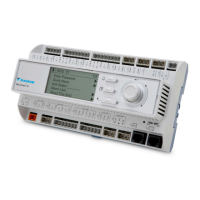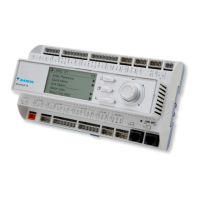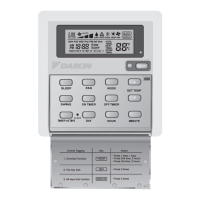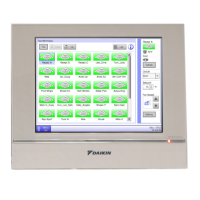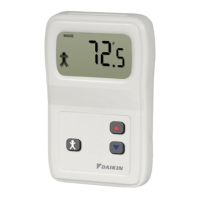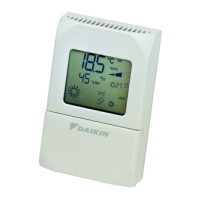Daikin IM 696-4 5
General Description
Analog Inputs Terminal Blocks
The MCB receives up to 16 analog input signals on four
terminal blocks
located on the left side of the board. From top
to bottom, analog inputs AI1 through AI4 are terminated on
the first terminal block, AI5 through AI8 on the second, AI9
through AI12 on the third, and AI13 through AI16 on the
fourth. Each analog input has two terminals. The terminals for
AI1 are 1 and 1C, the terminals for AI2 are 2 and 2C, and so
forth. Refer to “Analog Inputs-Main Control Board (MCB)”
on page 21 for details regarding analog inputs.
Binary Inputs Terminal Blocks
The MCB receives up to 16 binary input signals on three
terminal blocks located on the top of the board. From right to
left, binary inputs BI1 through BI6 are terminated on the first
terminal block, BI7 through BI10 on the second and BI11
through BI16 on the third. Refer to “Binary Inputs—Main
Control Board (MCB)” on page 23 for details regarding binary
inputs.
Binary Outputs Terminal Blocks
The MCB controls up to 16 binary outputs when controlling
the unit. The binary outputs either energize on-board
electromechanical relays (BO1 through BO4, BO11 and
BO12) or triacs (BO5 through BO10 and BO13 through
BO16).
The unit control devices are wired to th
ese relays or triacs
through six output terminal blocks on the right side of the
MCB. From top to bottom binary outputs BO1 and BO2 are
terminated on the first terminal block, BO3 and BO4 on the
second, BO5 through BO7 on the third, BO8 through BO10 on
the fourth, BO11 through BO13 on the fifth, and BO14
through BO16 on the sixth.
Each binary output has three terminals. The terminals for BO1
are NO, 1,
and NC, the terminal
s for BO2 are NO, 2, and NC,
and so forth. Each binary output lights an LED when the
output is active. Refer to “Binary Outputs—Main Control
Board (MCB)” on page 24 for details regarding binary outputs.
RS-485 Communications Terminal Block
The MCB exchanges information with up to four optional
auxiliary control boards via the RS-485 communication bus
terminal block in the lower left corner of the MCB. This
terminal block has four terminals, three of which are labeled
REF, Minus, and Plus. These terminals connect the auxiliary
boards to the RS-485 communication bus to interface them
with the MCB.
If unit is equipped with and evaporative condenser and a VFD
controlling the first condenser fan
on each circuit (condenser
fan #1
1 and #21), this VFD is also controlled via this RS-485
communication bus terminal block.
Power Supply Terminals
Transform T2 supplies 24 VAC power to the MCB on the 24V
and COM terminals located at the upper right corner of the
MCB.
Some of the binary outputs on the MCB drive 24 VAC pilot
relays in
the unit control circuit. 24 VAC to power these pilot
relays is provide from transformer T3, through the SRC 1–8
and SRC 9–16 terminals located at the upper right corner of
the MCB, and through the particular binary output contacts.
Place the output jumper associated with these outputs in the
SRC position. For detailed information regarding binary
output jumpers, refer to “Binary Outputs—Main Control
Board (MCB)” on page 24.
Keypad/LCD Display Connection
The keypad is connected to the main control board via a
six-conductor cable connected to a modular jack located at the
bottom of the MCB. This connects the keypad to the RS-485
communication bus interface with the MCB.
Communication Modules
In systems that require networking, one of the following
communications modules can be installed.
BACnet/IP Communication Module
A BACnet/IP Communication Module can be plugged into the
MCB as shown in Figure 4 on page 4.
The BACnet/IP Communication Module is design
ed to be an
add-on module to the MCB for networking to Building
Automation and Control Network (BACnet) systems. It is a
plug-in module that can be attached to the MCB via a 36-pin
header, and includes four locking stand-offs to securely attach
it to the board. The MicroTech II Applied Rooftop Unit
Controller meets the requirements of ANSI/AHRAE 135-2001
standard for BACnet/IP per Annex J of the standard with a
conformance level of 3.
For a detailed description and troubleshooting information
reg
arding
this communications module, refer to installation
and maintenance bulletin IM 703, MicroTech II Applied
Rooftop Unit Controller and Self-Contained Unit Controller
BACnet Communication Module—BACnet / IP. For details
regarding BACnet protocol data, refer to engineering data
document, ED 15060, MicroTech II Applied Rooftop Unit
Controller Protocol Information.
A unit equipped with the optional BACnet/IP Communication
Mod
ule is connected to an BACn
et network through an
eight-position RJ-48 style modular jack located on the bottom
edge of the MCB. This connection is shown schematically in
Figure 5 on page 7.

